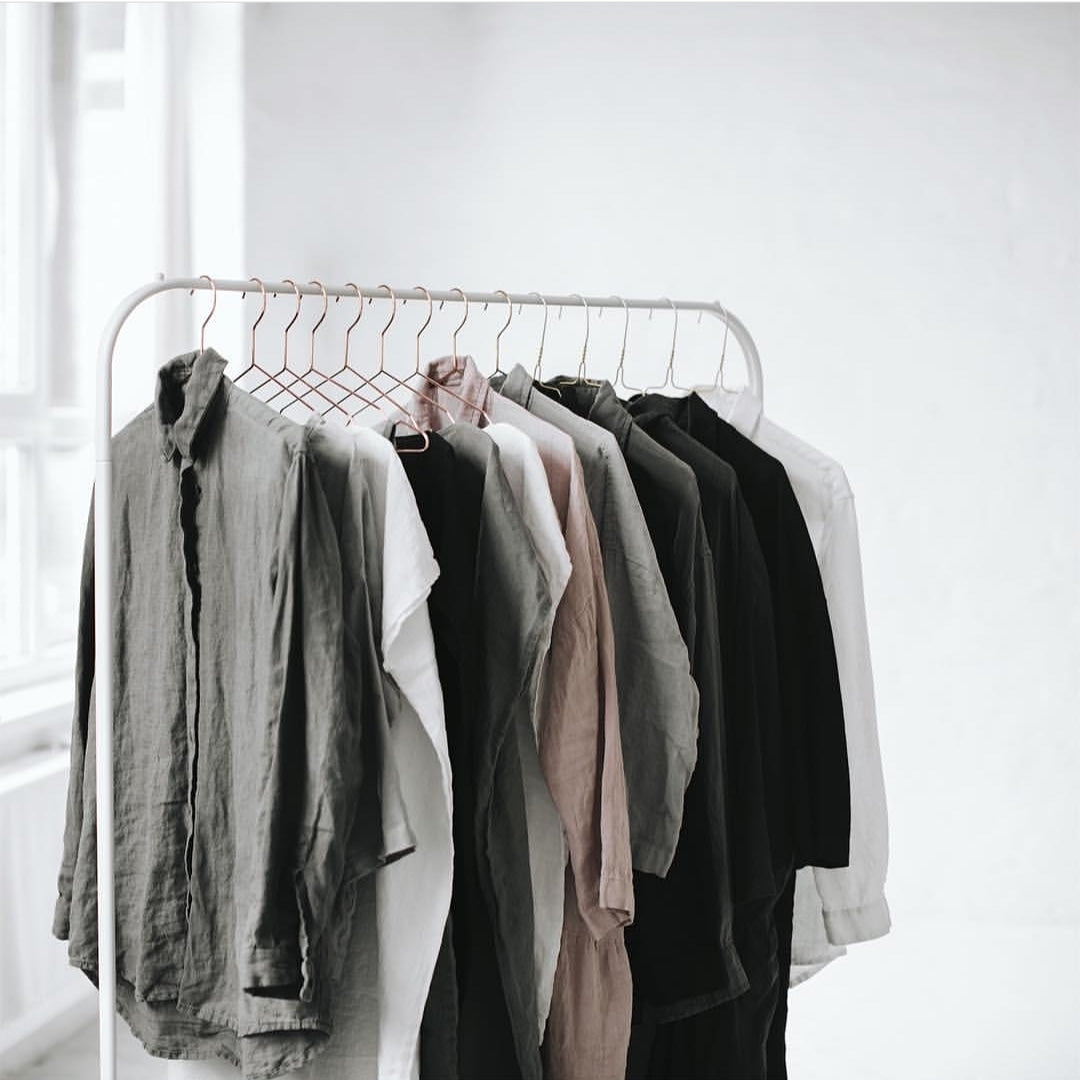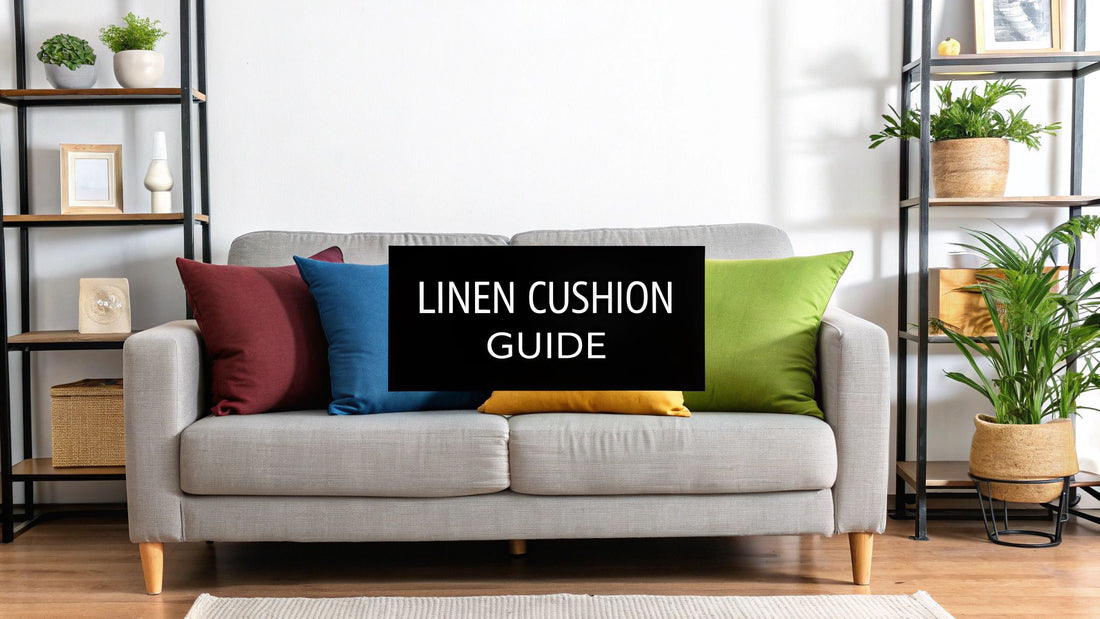Linen cushion covers bring a special kind of relaxed sophistication and natural texture into a room, making them a beautiful, timeless choice for any home. They're well-loved for their incredible durability, breathability, and the lovely way they soften over time, adding real character and comfort to your living spaces.
Why Linen Is the Perfect Choice for Your Home
When you're picking out textiles, the fabric itself sets the tone. Cotton is a common go-to and velvet feels luxurious, but linen offers something genuinely authentic. Think of linen cushions not just as accessories, but as core pieces that create a sense of calm, natural elegance. Their subtle, organic texture introduces a depth and warmth that synthetic fabrics just can't match.
This feeling fits perfectly with the modern New Zealand design ethos, where a connection to nature is key. Linen’s earthy quality supports biophilic design—the practice of bringing the outdoors in—to create spaces that feel both stylish and incredibly peaceful. It’s an investment in a lifestyle that appreciates quality, sustainability, and effortless beauty.
A Timeless and Sustainable Material
Linen comes from the fibres of the flax plant, which is a wonderfully resilient crop that needs far less water and fewer pesticides than cotton. This makes it a much more sustainable choice for anyone trying to make more eco-conscious decisions at home. The strength of linen also means your cushion covers aren't just a passing fancy; they are designed to be lived with and loved for years. To dive deeper into what makes this fabric so special, you can explore the benefits of pure natural linen.
Linen is like a fine wine; it genuinely gets better with age. Each wash softens the fibres, enhancing their natural lustre and that beautiful, lived-in feel without losing any of their strength.
A Growing Global Preference
This love for natural textiles isn't just happening here. The global cushion cover market is expected to grow from USD 13.86 billion to almost USD 18.86 billion by 2033, and a huge part of that is driven by people wanting natural fibres in their homes. The versatility and softness of materials like linen are at the heart of this shift towards more sustainable, high-quality furnishings around the world. You can read more about the cushion cover market's projected growth on Datahorizzon Research.
Understanding the Unique Properties of Linen
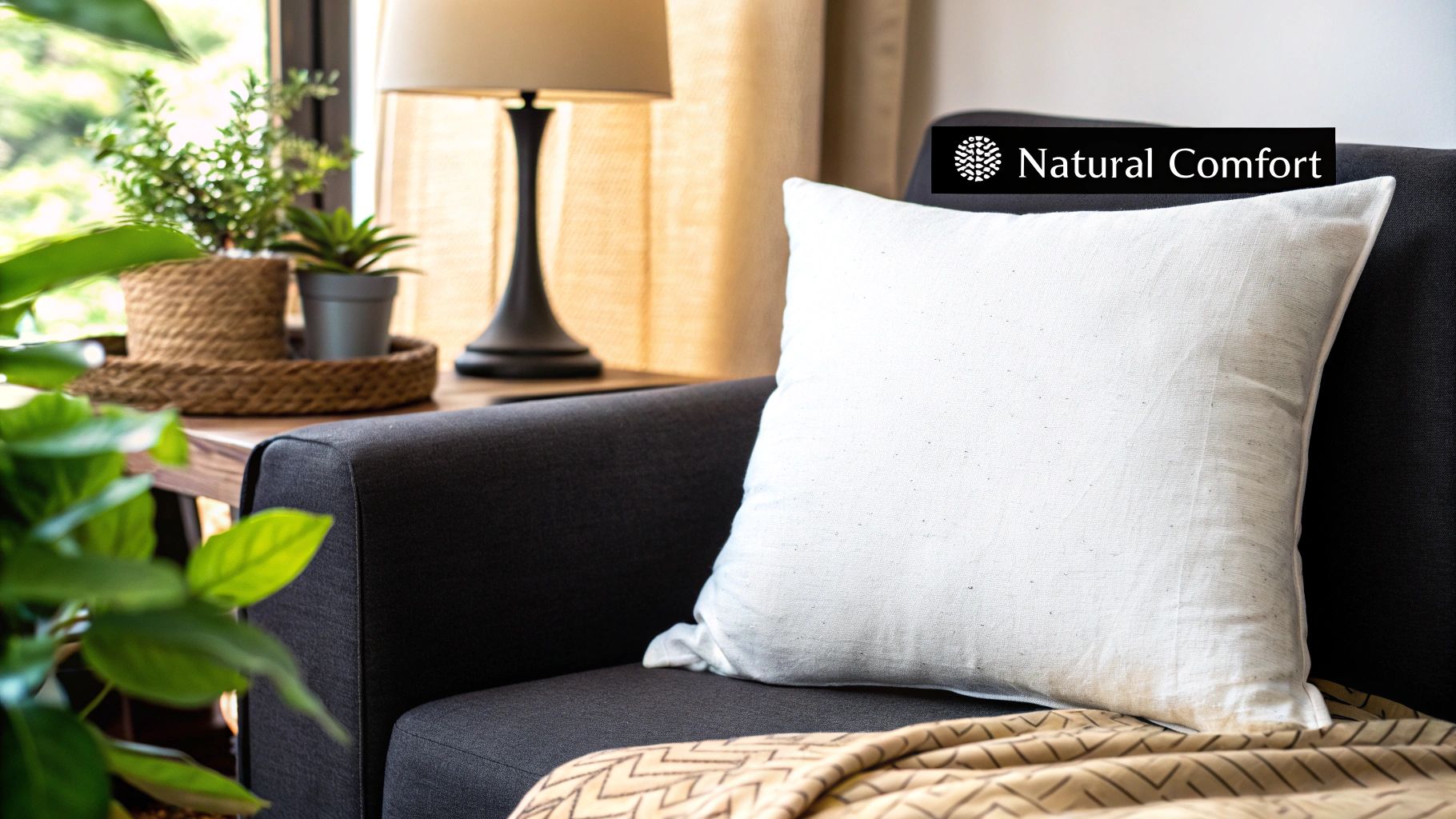
To really get why linen is so special, it helps to know where it comes from. It’s not made in a lab; every single thread starts its life as a flax plant, a hardy crop that’s been grown for literally thousands of years. This connection to the earth is the secret to all of linen's best qualities.
The magic is in the flax fibre itself. It's incredibly strong—one of the toughest natural fibres out there, in fact. This is why a good set of linen cushion covers isn't just a purchase, it's an investment. They’re built to handle the chaos of a busy family home, from kids' movie nights to pets claiming their favourite spot on the sofa, all without losing their shape.
But linen isn't just tough; it’s also incredibly smart when it comes to comfort. The fibres are hollow, which lets air move through the fabric with ease. In summer, this breathability wicks moisture away, leaving you with a cool, dry surface to relax on. Come winter, those same fibres act as a natural insulator, providing a touch of gentle warmth.
More Than Just a Fabric
Linen’s perks go far beyond its strength and feel. It’s also known for being a genuinely healthy material to have in your home. It’s naturally hypoallergenic and antibacterial, making it a brilliant choice for anyone with sensitive skin, allergies, or homes with little ones and pets running around.
These qualities have created a real buzz for linen goods here in New Zealand. While most of the finished textiles are produced overseas in places like China and India, Kiwis have always had a soft spot for high-quality, natural materials. This has made imported linen cushion covers a sought-after staple, prized for their sustainable roots and family-friendly nature. If you're curious about the global trends that bring these beautiful textiles to our shores, you can read the full furnishing market overview on IndexBox.
Linen is like a fine wine; it gets better with age. Unlike other fabrics that wear out, linen softens with every wash, developing a subtle lustre and a beautifully lived-in texture that only enhances its charm over time.
This means your cushion covers don’t just last—they evolve, becoming more yours with every passing year.
The Practical Advantages at a Glance
So, what does all this mean for your home? When you choose linen, you’re bringing in a whole host of real, tangible benefits that instantly lift your space.
- Lasting Strength: Linen is seriously resistant to pilling and fraying, so your cushion covers will stay looking fresh for years.
- Year-Round Comfort: Its natural ability to regulate temperature keeps you comfortable whether it's the height of summer or a chilly winter evening.
- Healthy Home Environment: Being naturally resistant to bacteria and allergens, it helps create a cleaner, fresher living space.
- Effortless Elegance: There’s just something about linen’s signature texture. It adds a layer of relaxed sophistication that feels both timeless and wonderfully inviting.
How to Choose the Right Linen Cushion Covers
Picking the perfect linen cushion covers can feel a lot like choosing art for your home. Each one adds to the room's overall story and vibe. To get it just right, we need to think beyond just the colour and consider the size, shape, and even the texture of the fabric itself. This guide will walk you through it, so you can choose with confidence.
First up, let's talk size. A classic mistake is buying cushion covers that are the exact same size as your cushion inners. If you want that plush, inviting look you see in magazines, you actually need to go a size down.
Pro Tip: For a full, plump cushion, choose a cover that is 5cm smaller than your cushion inner. A 50x50cm inner, for example, will perfectly fill out a 45x45cm cover. This simple trick is the secret to creating a luxurious, supportive cushion instead of one that looks a bit sad and saggy.
It’s a small detail that makes a huge difference, giving your cushions a professionally styled and incredibly comfortable finish.
Matching Size and Shape to Your Furniture
Getting the proportions right is everything when it comes to creating a balanced, cohesive look. Different cushion shapes and sizes have different jobs—some are there for back support on a deep sofa, while others are purely for show.
To get you started, here’s a quick reference for matching cushion sizes to their best use.
Standard Cushion Cover Sizes and Common Uses
| Size (cm) | Common Name | Best For |
|---|---|---|
| 45x45cm | Standard Square | The go-to for sofas, armchairs, and beds. Incredibly versatile. |
| 50x50cm | Medium Square | A slightly larger standard size, great for layering. |
| 60x60cm | Large Square / Euro | Perfect as a back layer on large sofas or as floor cushions. |
| 30x50cm | Small Lumbar | An accent cushion for armchairs or layered in front of squares. |
| 40x60cm | Large Lumbar | Provides great lower back support on a sofa or bed. |
Thinking about how these sizes work together is the key. You can see in this arrangement just how beautifully different styles can come together.
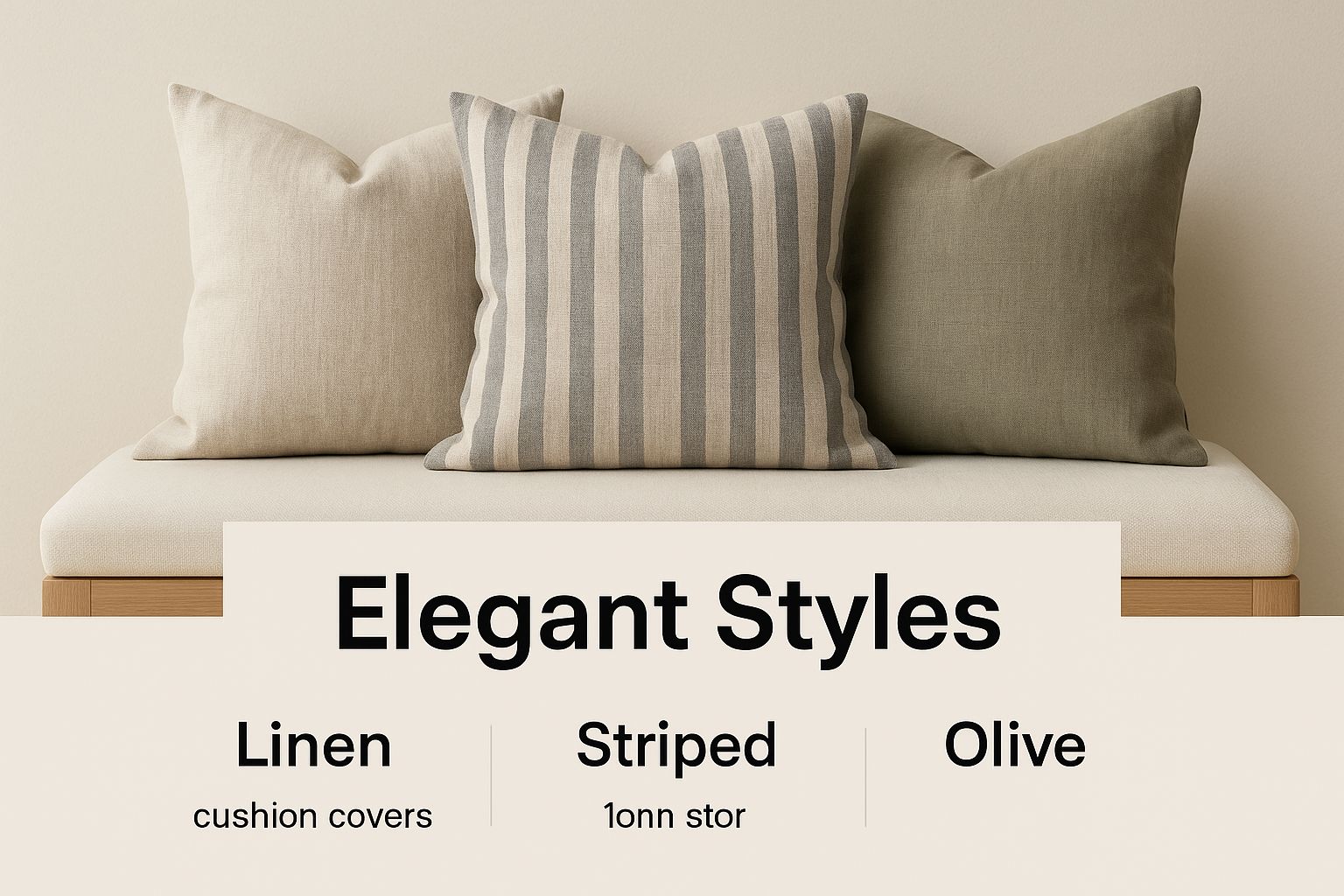
The image really shows how mixing up textures and sticking to a neutral palette creates a look that’s both sophisticated and effortlessly pulled together.
Understanding Linen Weaves and Finishes
Here's something you might not know: not all linen is created equal. The finish of the fabric can completely change its feel and appearance, which in turn influences the whole mood of your space. The two most common options offer very different experiences.
- Standard Linen: This is the linen you might think of first. It has a crisper, more structured feel with a clean, defined weave. It’s perfect for a more formal or tailored look because it holds its shape so well, offering a timeless, classic elegance.
- Stonewashed Linen: This is where things get interesting. This linen is pre-washed with stones (like pumice) or special enzymes to soften up the fibres. The result? A beautifully relaxed, slightly faded fabric that’s incredibly soft from day one. It just oozes a casual, lived-in luxury that’s perfect for making a room feel cosy and inviting.
If you’re curious about the technical side of things, you can learn more about the difference between pumice and enzyme washing in our deep-dive article.
Ultimately, choosing between them comes down to personal taste. Are you drawn to a sharp, clean aesthetic or a soft, rustic charm? Answering that will point you straight to the perfect linen cushion covers for your home.
Styling Your Home with Linen Cushions
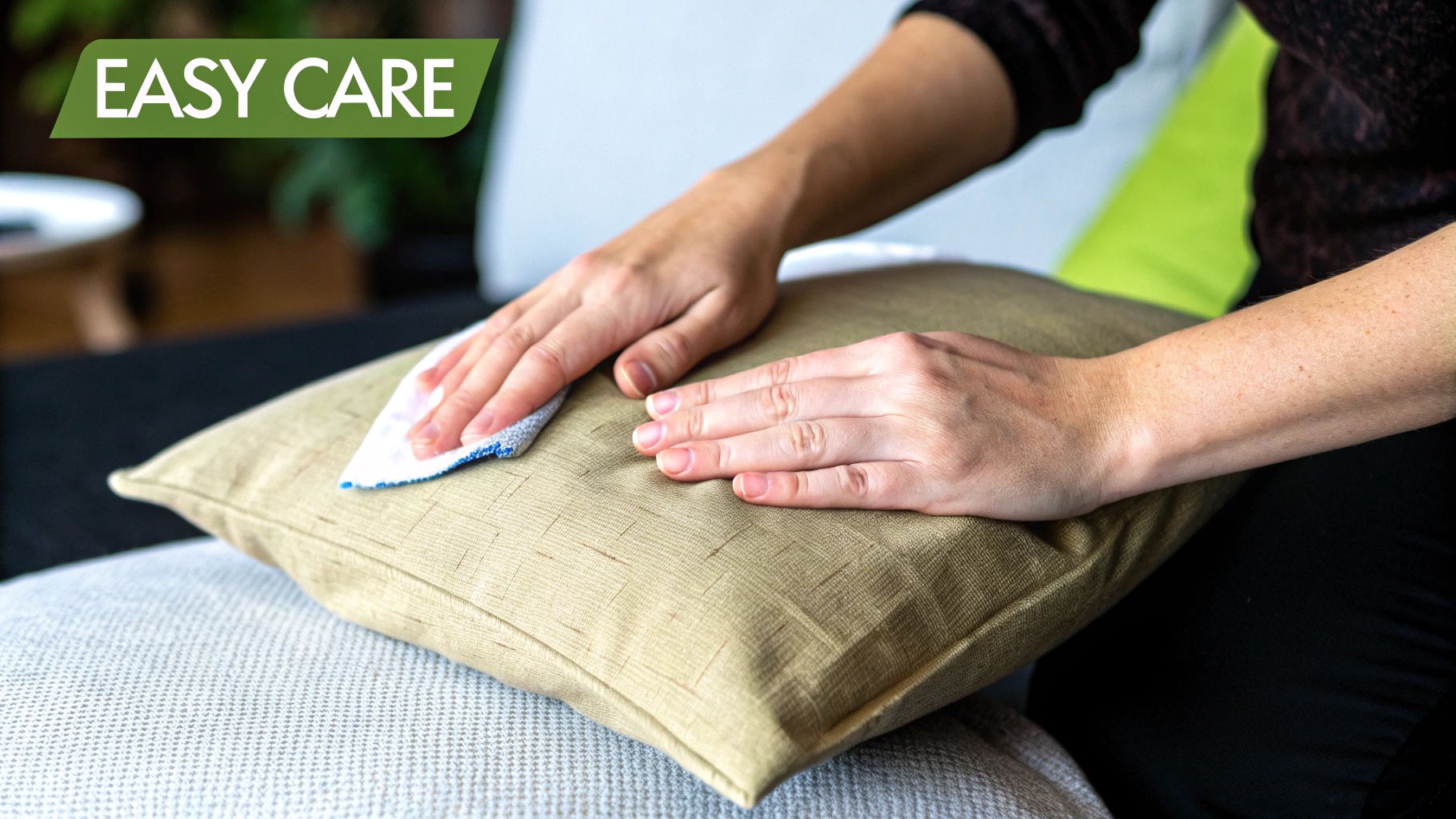
There’s a real art to styling with linen cushion covers. It’s not just about plumping up a cushion and tossing it on the sofa; it’s about bringing personality, warmth, and texture into a room. When you get it right, your furniture looks complete, intentional, and incredibly inviting.
Think of it like an artist layering paint on a canvas. You can build up depth and interest on your sofa or bed in much the same way. Linen, with its beautiful, organic feel, makes the perfect base layer. From there, you can start mixing in other materials to create a space that’s a delight for the senses.
Create Depth with Textures and Tones
The secret to that polished, professionally styled look often comes down to one thing: mixing textures. Linen has a naturally tactile, slightly raw quality that works wonderfully with other fabrics. Try pairing your linen cushions with a chunky woollen knit, a smooth cotton velvet, or even a sleek leather piece. This contrast between different surfaces is what creates real visual interest and makes a space feel warm and lived-in.
Colour is just as important. For that calm, minimalist vibe so many of us love in our Kiwi homes, a tone-on-tone palette is a winner. Layering different shades of the same colour family—think soft grey, oatmeal, and a touch of cream—creates a sophisticated look where the textures are left to shine.
Master the Rule of Three for Balance
If you take away just one styling trick, make it the rule of three. For some reason, our eyes find arrangements in odd numbers more appealing and dynamic than even ones.
Grouping cushions in threes (or fives, if you have a big corner sofa) just feels right. It stops things from looking too rigid or perfectly matched, giving you a look that feels balanced but beautifully relaxed.
Putting it into practice is simple. Try arranging a trio of cushions in one corner of your sofa. A go-to combination that never fails is:
- Start with one large square cushion at the back (a 60x60cm is perfect).
- Layer a medium-sized square cushion in front, perhaps in a complementary colour or texture.
- Finish with a smaller rectangular lumbar cushion right at the front to complete the group.
This simple layered approach doesn't just look great—it also adds some serious comfort and support.
Styling Recipes for Kiwi Homes
Because linen is so versatile, it slots perfectly into the interior styles we see across New Zealand. To help you get started, here are a few 'recipes' for styling your linen cushion covers:
- Coastal Calm: Think stonewashed linen in shades of crisp white, sandy beige, and a soft, watery blue. Mix in a cushion with a subtle pinstripe, and team it all with a jute rug and light-coloured timber for that classic, breezy bach feel.
- Modern Farmhouse: Go for linen in earthy, grounded tones like olive green, charcoal, and warm grey. Pair them with a cosy, chunky knit throw on a classic leather or deep-seated fabric sofa to nail that rustic-yet-refined aesthetic.
- Minimalist Serenity: Here, it’s all about a clean, monochromatic palette of whites, creams, and beiges. Let the gorgeous texture of the linen do all the talking. Keep the arrangement simple and uncluttered—just two or three cushions will maintain that beautiful sense of space and calm.
A Simple Guide to Caring for Your Linen
One of the most appealing things about linen is that it’s incredibly durable, but knowing a few simple care tricks will help your cushion covers last a lifetime. Looking after linen properly is surprisingly straightforward, and it’s the key to preserving the fabric’s strength and gorgeous texture. In fact, it just gets softer and more inviting with every wash.
The best part? Caring for high-quality linen cushion covers isn’t some complicated, time-consuming chore. Most linen is machine washable, which is a lifesaver in any busy home. The main thing to remember is to treat it gently to protect those natural flax fibres.
Machine Washing Your Linen
For the best results, always pop your covers on a gentle machine cycle using lukewarm or even cool water. High temperatures aren't a friend to linen, as they can cause the fibres to weaken or shrink over time.
You’ll also want to use a mild, liquid detergent. Harsh powders can sometimes leave a residue that dulls the fabric’s beautiful natural lustre. It's also a good idea to steer clear of bleach or detergents with optical brighteners, as these can easily discolour and damage the linen.
The secret to keeping linen soft and beautiful is to avoid overcrowding the washing machine. Give your cushion covers plenty of room to move around – this prevents them from getting too creased and ensures they get a thorough, gentle clean.
Once they're washed, you've got a couple of options for drying. While you can tumble dry them on a low heat setting, line drying is really the gold standard. It’s not only better for the fabric and the planet, but it also helps to naturally smooth out some of the wrinkles.
Handling Stains and Wrinkles
Life happens, and so do spills. When they do, the trick is to act fast. Blot the stain straight away with a clean, damp cloth. Whatever you do, don't rub it! Rubbing can just push the stain deeper into the fibres. For more stubborn marks, a gentle stain remover designed for natural fabrics can be applied before you wash it.
Now for the big question with linen: to iron, or not to iron?
- For a crisp, formal look: Iron your cushion covers while they're still slightly damp. Use a medium-hot setting on your iron, and you'll find it much easier to get that smooth, polished finish.
- For a relaxed, natural look: Just embrace the wrinkles! That signature crumpled texture is a huge part of linen’s charm and what gives it that comfortable, laid-back feel.
This fuss-free maintenance is a big reason why linen homewares are so sought-after. Here in New Zealand, the manchester retailing industry, which includes these kinds of products, was valued at around NZD 571.3 million in 2024. It just goes to show how much we love quality home textiles. You can see more about the global home textile market on Fortune Business Insights.
For a more detailed breakdown of washing, drying, and general maintenance, have a look at our complete linen care guide. It’s packed with extra tips to keep your linen looking its absolute best for years to come.
Common Questions About Linen Cushion Covers
Even with a fabric as classic and well-loved as linen, it’s natural to have a few questions before bringing it into your home. When it comes to linen cushion covers, the same queries tend to pop up, usually around the practical side of living with the material day-to-day.
Think of this as the final piece of the puzzle. We’re here to tackle those common questions head-on, from wrinkling to durability, so you can feel confident that you're making a choice you'll be happy with for years to come.
Do Linen Cushion Covers Wrinkle Easily?
In a word, yes. Wrinkling is one of linen’s most well-known traits. It happens because the flax fibres have very little natural elasticity, so they don’t just spring back into place like synthetic fabrics do.
But here’s the thing: most people who love linen see this as part of its charm. Those gentle creases give it a relaxed, organic, and lived-in look that’s hard to replicate. Stonewashed linen, in particular, really embraces this quality, giving you a soft, beautifully textured feel right from the start.
If you're after a crisper, smoother finish, it's an easy fix. Just iron your cushion covers while they're still slightly damp. You’ll also find that with every wash, the fibres soften up, and the wrinkling becomes much gentler and less pronounced over time.
This natural evolution is exactly what makes the fabric so special.
Are Linen Cushion Covers Good for Homes with Pets and Children?
Absolutely. In fact, linen is a surprisingly smart choice for a busy, bustling household. It’s one of the strongest natural fibres out there—significantly more durable than cotton—so it can handle the rigours of daily life and frequent washing without a problem.
Its inherent strength means it won't stretch out of shape easily, keeping your cushions looking great for the long haul.
Beyond its sheer toughness, linen has other handy properties. It’s naturally antibacterial and repels dirt, which is a massive plus when you have kids and pets running around. Small spills often just bead up and can be blotted away before they even think about setting in, making upkeep much simpler than you might expect.
What Is the Difference Between 100% Linen and a Linen Blend?
The right choice here really boils down to your budget and what you value most.
A cushion cover made from 100% linen gives you the full, premium experience. You get that incredible breathability, moisture-wicking ability, and legendary durability. It also develops that unique, soft texture that only gets better with age. It's the more luxurious and long-lasting option, without a doubt.
A linen blend, which is usually mixed with cotton, is a more budget-friendly alternative. It often feels a bit softer right away and won’t wrinkle quite as much as pure linen. The trade-off is that you might not get the same level of strength, and it won't develop that distinct, sought-after character that pure linen is famous for.
Can You Use Linen Cushion Covers Outdoors?
While linen is incredibly tough and dries quickly, it isn't really designed for a life spent entirely outdoors. If left in direct, harsh sunlight for long periods, the beautiful colours will inevitably start to fade.
Likewise, if left out in the damp, it can be susceptible to mildew, just like any other natural fibre.
That doesn't mean they have to be confined indoors, though. They can look beautiful on a covered veranda, a sheltered patio, or in an outdoor room where they’re protected from the worst of the weather. For fully exposed areas, however, you're always better off choosing a fabric that's been specifically treated for UV and moisture resistance.
Ready to bring timeless elegance and natural texture into your home? Explore the curated collection of premium linen homewares at The Foxes Den and find the perfect pieces to elevate your space. Discover our collection today.
